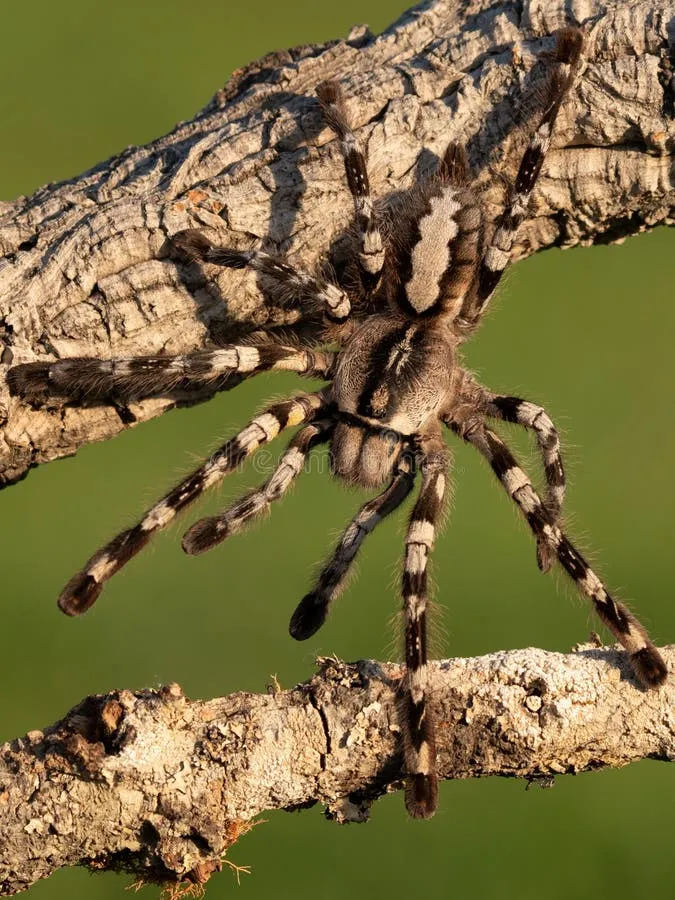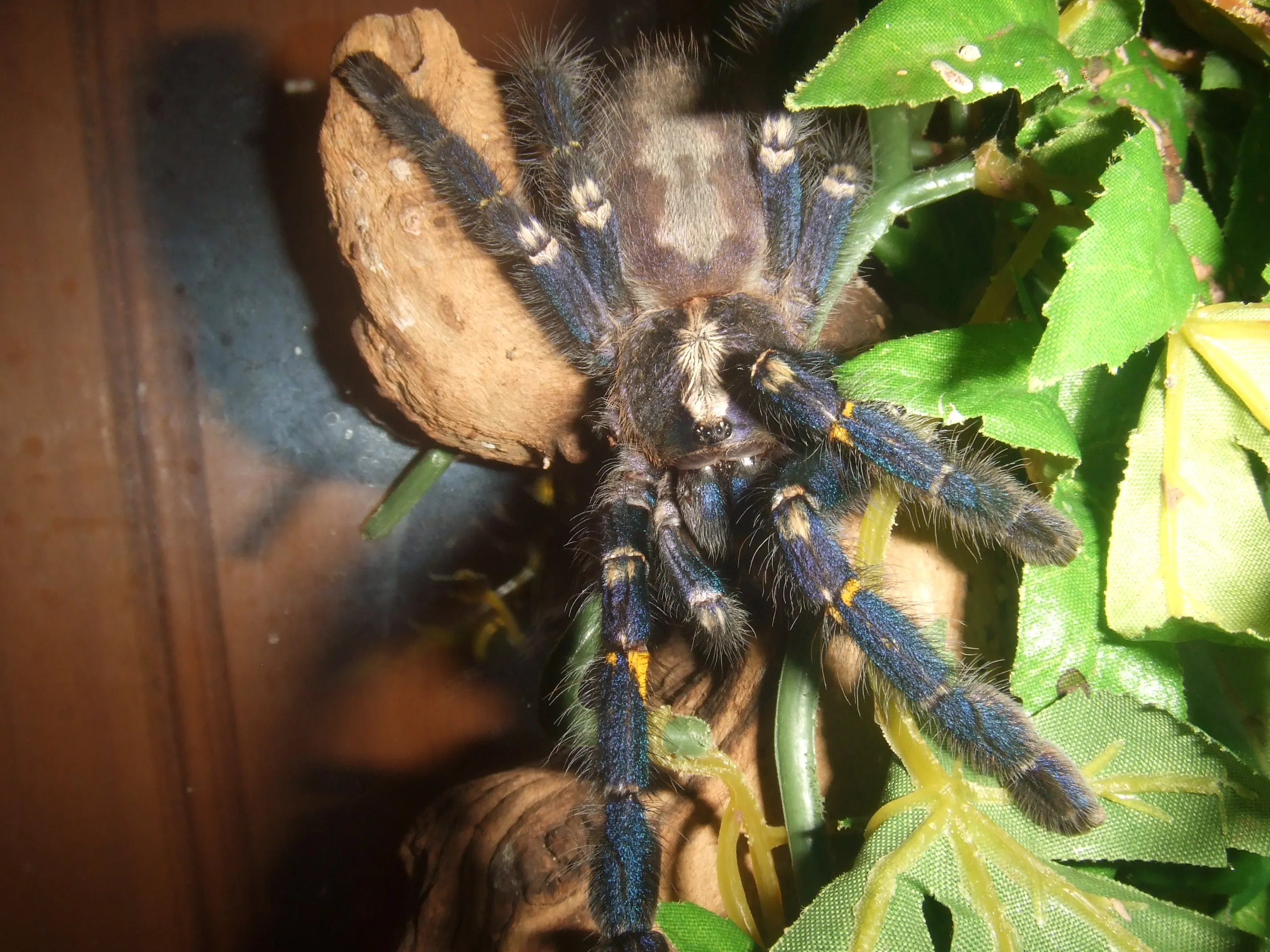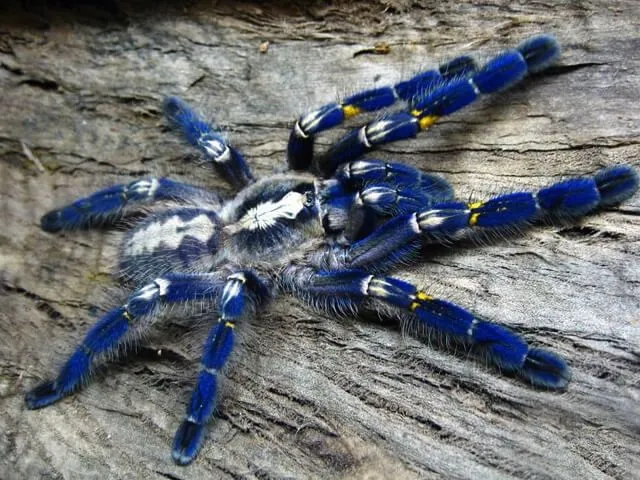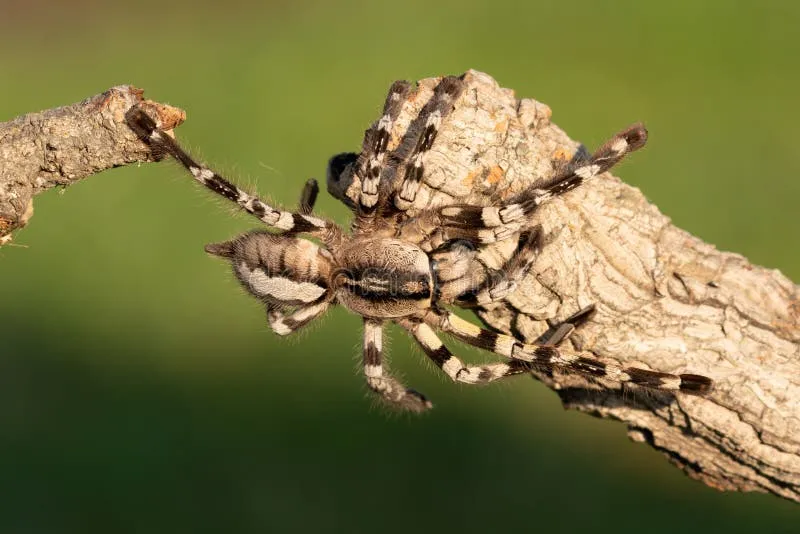Understanding the Blue Tarantula (Poecilotheria metallica)
The Blue Tarantula, scientifically known as Poecilotheria metallica, is a stunning arboreal species native to a small area in India. Its vibrant blue coloration, especially prominent on its legs and carapace, makes it a highly sought-after pet among arachnid enthusiasts. However, their striking appearance is matched by specific care requirements that are crucial for their well-being. These tarantulas are fast-moving and possess potent venom, so responsible ownership and careful handling are paramount. Understanding the Blue Tarantula’s natural habitat, behaviors, and needs is the first step towards creating a thriving environment for this exotic pet. It’s also vital to research and understand the potential risks and challenges involved in keeping this species before acquiring one. This guide will provide the necessary knowledge to ensure your Blue Tarantula lives a long, healthy, and stress-free life, allowing you to appreciate its beauty and unique characteristics safely.
Habitat and Enclosure Setup
Creating a suitable habitat is fundamental to the health and happiness of your Blue Tarantula. Because they are arboreal, they require a vertically oriented enclosure. A secure and well-ventilated terrarium is essential, preventing escapes and ensuring proper airflow. The size of the enclosure should be appropriate for the tarantula’s size, with juveniles needing smaller spaces to feel secure and adults requiring larger ones. Providing the right environment will mimic their natural habitat, reducing stress and encouraging natural behaviors. The enclosure should also be easy to maintain, allowing for convenient cleaning and monitoring of environmental conditions. Proper setup ensures the tarantula can thrive and exhibit its natural behaviors.
Choosing the Right Enclosure

The ideal enclosure for a Blue Tarantula should be made of glass or acrylic, offering clear visibility and ease of cleaning. A good starting point for a juvenile is a terrarium that is approximately 8x8x12 inches, increasing to a minimum of 12x12x18 inches for adults. Ventilation is critical; ensure the enclosure has cross-ventilation to prevent the buildup of moisture and stale air. A secure lid is non-negotiable, as these tarantulas are escape artists. Consider a lid that locks or has secure clips. Avoid enclosures with sharp edges or small gaps where the tarantula could get trapped. Furthermore, the enclosure should be placed in a location away from direct sunlight, drafts, and excessive noise or vibrations, which can stress the tarantula.
Substrate Selection
The substrate serves multiple purposes including moisture regulation, providing a surface for the tarantula to walk and burrow on, and contributing to the overall aesthetics of the enclosure. A good substrate choice for a Blue Tarantula is a mixture of coconut fiber, peat moss, and a small amount of vermiculite. This blend retains moisture well while allowing for good drainage. Avoid using substrates with sharp particles or those that can harbor mites. The depth of the substrate should be sufficient for the tarantula to burrow if it chooses. Typically, a depth of 2-4 inches is adequate for juveniles and adults alike. Regularly monitor the substrate for cleanliness and replace it every few months or as needed to prevent the buildup of waste and mold. Maintaining the appropriate substrate conditions is a vital element in the well-being of your pet.
Temperature and Humidity Control
Blue Tarantulas thrive in specific temperature and humidity ranges. Aim for a temperature between 75-85°F (24-29°C). Use a thermometer to monitor the temperature and a low-wattage heat source, such as a heat mat placed on the side of the enclosure (never under it) or a ceramic heat emitter, if necessary, to maintain the ideal temperature. Humidity should be maintained at 60-70%. This can be achieved by misting the enclosure lightly with dechlorinated water every few days, ensuring the substrate is slightly moist but not waterlogged. A hygrometer can help monitor humidity levels. Proper ventilation is crucial to prevent mold and mildew growth. Consistent temperature and humidity levels are key to mimicking their natural environment and ensuring the tarantula’s health.
Feeding Your Blue Tarantula

Providing proper nutrition is crucial for your Blue Tarantula’s growth and well-being. Their diet consists primarily of live insects, and the type, size, and frequency of feeding depend on the tarantula’s age and size. Overfeeding can be as harmful as underfeeding, so it’s essential to monitor your tarantula’s condition and adjust the feeding schedule accordingly. Regular feeding provides the necessary energy and nutrients for these creatures to thrive, shedding their exoskeletons, and showcasing their beautiful colors. A balanced diet and regular feeding are critical for the overall health and longevity of your Blue Tarantula. Always remove uneaten food items to prevent mold growth and ensure a clean environment for your pet.
Dietary Needs
Blue Tarantulas are insectivores and require a diet of live insects. Suitable food items include crickets, roaches, mealworms, and occasionally, waxworms as a treat. The insects should be gut-loaded before feeding, meaning they are fed a nutritious diet themselves to pass essential nutrients to the tarantula. Avoid feeding insects that are too large for your tarantula, as this can lead to injury. The prey should be approximately the size of the tarantula’s abdomen or slightly smaller. Variety in the diet is recommended to ensure a balanced intake of nutrients. Regularly check and replenish the insect feeders and consider adding a vitamin supplement to the insect feed to ensure the tarantula receives all the required nutrients.
Feeding Frequency and Amount
Feeding frequency depends on the tarantula’s age and growth rate. Spiderlings should be fed 2-3 times per week, while juveniles can be fed every 5-7 days. Adult tarantulas typically eat every 1-2 weeks. Adjust the feeding schedule based on the tarantula’s appetite and condition. If the tarantula refuses food or appears overly plump, reduce the feeding frequency. Always offer an appropriate amount of food; a single cricket or roach is usually sufficient for juveniles, while adults may consume several insects at a feeding. Remove any uneaten prey within 24 hours to maintain a clean and healthy environment. The key is to observe your tarantula and adjust the feeding accordingly to ensure it remains healthy and well-nourished.
Watering and Hydration

Providing a clean water source is vital for your Blue Tarantula’s hydration. A shallow water dish with fresh, dechlorinated water should be available at all times. The water dish should be small enough to prevent the tarantula from drowning. Alternatively, you can mist the enclosure lightly with dechlorinated water 2-3 times a week, ensuring the substrate is slightly moist. Observe the tarantula’s behavior; if it appears dehydrated, mist the enclosure more frequently. Regularly clean and refill the water dish to prevent bacterial growth and maintain optimal hygiene. Always ensure the water provided is safe and free from harmful chemicals, which could negatively impact the tarantula’s health.
Handling and Safety Precautions
Handling Blue Tarantulas is generally not recommended, especially for inexperienced keepers. These tarantulas are known for their speed and potent venom. If handling is necessary, it should be done with utmost care and knowledge of the tarantula’s behavior. Always be prepared for a possible bite and understand the potential risks. The priority should always be the safety of both the keeper and the tarantula. Prioritize observing and interacting with the tarantula within its enclosure, where it feels safe and secure. Minimizing handling can reduce stress for the tarantula and minimize the risk of accidents.
Safe Handling Techniques
If handling is absolutely necessary, do so only when the tarantula is calm and not exhibiting defensive behavior. Approach the tarantula slowly and gently. Use a soft brush or a similar tool to gently encourage the tarantula to move onto a container or your hand. Never grab or startle the tarantula. Keep your movements slow and deliberate to avoid sudden reactions. Always handle the tarantula close to the ground or a soft surface to minimize the risk of injury if it falls. Ensure you have a clear path back to the enclosure. Remember that even a gentle tarantula can react defensively. Have a plan in place if the tarantula becomes agitated or attempts to flee. Wash your hands thoroughly after handling.
Recognizing Stress Signals

Knowing how to identify stress signals in your Blue Tarantula is crucial for its well-being. Defensive postures include raising the front legs, displaying fangs, and flicking urticating hairs (if present). If the tarantula is constantly hiding, refusing food, or exhibiting erratic behavior, it is likely stressed. Other signs include loss of appetite, sluggishness, or frequent attempts to escape the enclosure. If you notice any of these signs, reassess the tarantula’s environment. Check the temperature, humidity, and hiding places, and eliminate any potential stressors. Minimize handling, and provide a secure, comfortable environment. Promptly addressing stress signals can prevent serious health issues and promote a happier, healthier tarantula.
Health and Common Issues
Blue Tarantulas, like all tarantulas, can be susceptible to certain health issues. Recognizing the signs of illness and taking preventative measures are essential to ensure the longevity of your pet. Common issues include parasites, fungal infections, and problems related to molting. Regular monitoring, a clean enclosure, and a balanced diet can go a long way in preventing health problems. Promptly addressing any health concerns is crucial, as early intervention often leads to better outcomes. A proactive approach to health management helps to keep your Blue Tarantula healthy and comfortable.
Identifying Common Diseases
Several health issues can affect Blue Tarantulas. Parasitic infections are common, often caused by mites. Signs of a mite infestation include small, moving specks on the tarantula or in the enclosure. Fungal infections can arise from poor ventilation and excessive humidity. Look for discoloration or lesions on the tarantula’s body. Molting problems, where the tarantula struggles to shed its old exoskeleton, can be a sign of environmental stress or nutritional deficiencies. Other signs of illness include lethargy, loss of appetite, and changes in the tarantula’s behavior or appearance. Consult with an experienced tarantula keeper or a veterinarian specializing in exotic animals if you suspect your tarantula is ill.
Preventative Measures

Preventing health issues in your Blue Tarantula involves several key practices. Maintaining a clean and well-ventilated enclosure is essential. Regularly clean the enclosure, replace the substrate, and remove any uneaten food. Ensure the appropriate temperature and humidity levels. Provide a balanced diet of gut-loaded insects and fresh water. Quarantine new tarantulas before introducing them to existing collections to prevent the spread of parasites or diseases. Monitor your tarantula’s behavior and appearance regularly, and promptly address any signs of illness or stress. Regular observation and a proactive approach can significantly reduce the risk of health problems and ensure your Blue Tarantula thrives.
Breeding and Reproduction
Breeding Blue Tarantulas is a rewarding but challenging endeavor, best undertaken by experienced keepers. Successful breeding requires understanding the species’ specific needs, including their mating behaviors, environmental requirements, and the care of spiderlings. Preparing for breeding includes conditioning both the male and female with proper nutrition and environmental conditions. The process involves introducing the male to the female’s enclosure and carefully observing their interaction. Post-mating care includes providing the female with ample food and maintaining a stable environment for egg sac production. Successfully hatching and rearing spiderlings requires specialized knowledge and meticulous attention to detail. Breeding should only be attempted by those with the necessary expertise and commitment.
Breeding Blue Tarantulas requires advanced knowledge and commitment. This species is known for its vibrant colors and unique appearance, making it a popular choice for many. Understanding the care requirements from habitat, feeding, and health precautions is very important. By providing a suitable environment and following these guidelines, you can help your Blue Tarantula thrive and enjoy the beauty and wonder of this amazing species.
